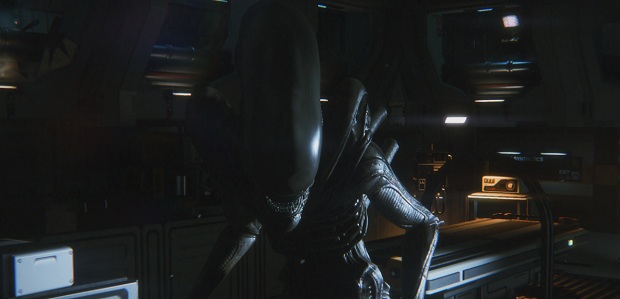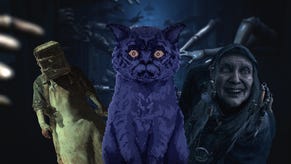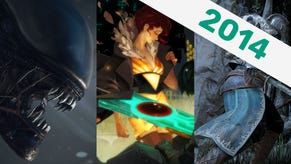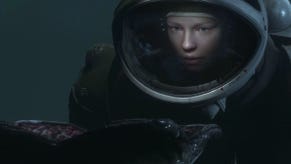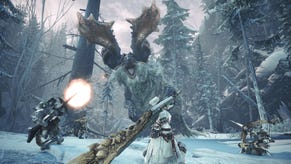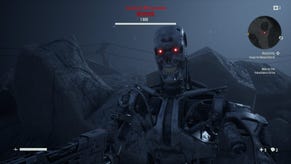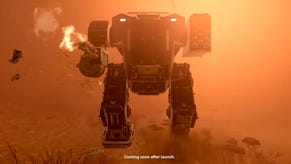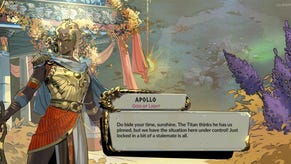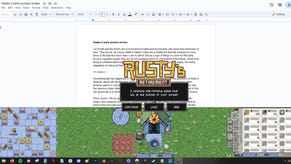Hands On: Alien Isolation
One word: hide
Expectations? Enormous. Alien: Isolation is a first-person stealth/horror adaptation of my favourite film. Not a direct adaptation but a digital recreation, in terms of both its setting and its style. I've been starved of horror games in recent years and this one has a lot to live up to. Several hours in the company of the creature have just about convinced me that it might be time to believe.
Last week I visited Sega to play around four hours of Alien: Isolation then, a couple of days later, I received code to play at home. It's important to make the distinction between the experience of playing in a room with the lead designer and five other writers and that of playing through the same sections of the game alone, in the dark, with the volume turned up high enough that I can not only HEAR a pin drop, but almost evacuate the room and my bladder whenever I do.
In the first environment, playing the game for the first time and occasionally interrupting myself to share anecdotes with a neighbour, Alien: Isolation was a game of tension and nervous laughter. There's nothing funny about young Ripley's situation – we pick up a little way into the game, just as everything on the Sevastopol is going to hell. The first task is to enter the medical area to find supplies for a wounded ally. Somebody asks Ripley what he should do if the 'creature' shows up. Her response could be the large print bolded instruction that forms the majority of the game's manual: 'Hide'.
Hiding is the natural response when the xenomorph enters a room. The first time it appears, in one of only two fully-scripted sequences I can recall in the hours I played, a vent bursts from the ceiling and smoke spills from within, screening the creature as it unfolds to the floor, almost like liquid. And then it stands and starts to hunt.
It's taller than I expected. Coming face to face with a creature that is at once alien and yet such a familiar image is strange. It's the first time that I've encountered Giger's horror in a game and found it quite so startling and unnerving, and that's probably partly because of the game's aesthetic. Quite simply, the Sevastopol is one with the Nostromo. It's of the same world, from the clunking key-operated machinery of save point terminals that take precious, anxious seconds to activate, to the whirrs and beeps of computers slowly coughing up their data. Every terminal and device, like Mother's interface, feels like it must be punched with weary authority rather than stroked and caressed like the slinky screens of Minority Report or the gadgets that today's youths use to take their selfies.
The seventies tech of Alien is awesome and terrible in its fragility, and more so than ever in this recreation. Reading this, wherever you might be and whatever kind of screen the words are on, you have more science at your fingertips than Ripley has in her entire inventory. Every broken down bleep is a reminder of the futility of craft and creation against the perfect organism. Which brings us back to that instruction: hide.
Escaping from the alien and traversing each area takes on a rhythm, as most activities in games tend to do.
The rhythms of Alien involve running, hiding, avoiding and distracting. Ripley's tools range from an actual revolver (useful against humanoid enemies, equivalent to a 'bite me' sign stuck to her back when it comes to the xenomorph) to noisemakers and flares. The latter can be used to draw attention away from an escape route or objective, but the couple of seconds that pass as the burning object is in hand, illuminating and hissing angrily, are torture. The game teaches you, through the medium of jaws within jaws and spikey appendages, to move slowly and remain unseen. Anything that compromises that approach, even for a moment, feels like a possible death.
There's a danger that Alien will be played mostly with eyes on the motion detector rather than the environment. Like an RTS that offers luscious, complex 3D terrain that is superseded by the efficiency of a minimap, Isolation's actual physical spaces (in which there is much screaming to be heard) can be a distraction. The detector is life. When the alien is prowling, which is always, no move should be made before first checking what direction death waits in, how quickly it is moving and in which direction. There's a sickening blend of relief and unease whenever the blip suddenly vanishes. It's in the vents, moving at terrifying pace at the periphery of even the scanner's vision, or it's waiting, silent and still.
And the key difference between playing in company and playing alone lies in the reaction to those moments – when the alien behaves in an unexpected manner and sends me scurrying to the nearest locker, how do I react? With people around, suffering the same fate, the tendency was to swear and to laugh, nervously and in sympathy. Like Ash, we were impressed by the nature of the beast and admired its tenacity. Its movements, sounds and animations add up to a convincingly animalistic set of behaviours. There is a personality to the creature and it's easy to ascribe motivations to its appearances and assaults, but they are fairly simple murderous motivations. That suits the fiction as well as the style of play. The xenomorph doesn't need to do more than shock and slaughter because that is its role, and it seems to fulfil it efficiently.
I was slightly concerned that the game was tense rather than terrifying. Holding your breath in a locker as the thing stands outside, dripping hate, is claustrophobic and anxiety-inducing. Black spots start to swim in Ripley's vision as she almost chokes herself in a bid to remain hidden. The game is a sequence of nightmarish situations, all tumbling out of sequence rather than anticipated by a script, but it didn't frighten me until I played it alone.
That makes sense, of course, but it's a relief to discover that I'm not immune to the panicked flight response all the same. When I played at night, in the dark, headphones on, I lived for longer after every death because I became less capable of taking risks. Being caught and killed began to seem like the worst fate imaginable. There was a moment, as I crawled beneath the floor in a utility tunnel and heard the panicked voices of people above, that I realised what my situation was akin to – Isolation makes me feel like the thugs in an Arkham game would feel. Something is hunting, moving with terrifying pace and mostly invisible, and it hides in shadow, emerging like a knife in the dark to pick off anything with a pulse.
For better and worse, Isolation is shaping up to be the game that was promised. The alien doesn't follow a simple set of directions during each encounter, it follows a programmed set of habits, instincts and behaviours. It's unstoppable and lethal, punishing the slightest mistake or act of bravado. If you've played Amnesia, you'll remember the moment that you realised nothing was hunting you in most areas and that the sounds were the creaks of a ghost train's animatronics.
The xenomorph is predictable to an extent, but it certainly isn't a mechanical skeleton bursting from the shadows and shaking at the end of a stick. It investigates sources of sound and light, follows movement, and kills anything that moves. Alarmingly, it even defies the conventions of the horror movie hunter. My most memorable moment with the preview build came when I encountered a group of terrified, hostile humans. The alien was at my back, prowling, and they were between me and the area's one exit. I threw a noisemaker into their midst and rolled under a table.
A green blur on the motion tracker shot toward the group. They screamed, they fired their weapons, they begged for mercy. I decided to make my escape while the creature fed on their shredded remains, darting toward the next room, and it was only when I heard the clattering of chitin on metal and a horrible shriek behind me that I realised – the alien doesn't feast on remains and it doesn't celebrate its kills. It engages, executes and leaves a pile of steaming entrails in its wake. Then it moves on to the next target.
All that I saw of it was the tail as it punctured my stomach and a spider-like hand gripping my face from behind, preparing to snap the head from its stem.
The difficulty (I played on hard) means that areas become familiar due to repeated attempts to survive them in one piece and there's certainly a risk that the novelty of the aesthetic will become insignificant as frustration builds. But that's why the inclusion of humanoid obstacles, synthetic and organic, is necessary rather than an interruption or concession to gunplay. They're still things to avoid rather than confront, if at all possible, and add new and unexpected interactions in the midst of the familiar rhythms. Complications of any sort add to the texture of unease and prevent each series of corridors and rooms from becoming a different shaped box to hide in.
More than any single anecdote or moment of anguish, I'm fixated on the simple fact of the alien's uncanny existence. Its movements can be seen and tracked, but they are never known, as it sometimes scrambles into view and sometimes passes by, less than foot away, inside a wall. A relationship builds between predator and prey, but it's one of awe and anxiety rather than a mechanical understanding. The alien, even as it stands fully in view, remains terrifying and unknown. And that's exactly as it should be.






